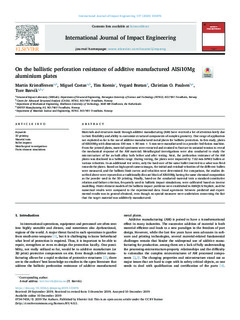| dc.contributor.author | Kristoffersen, Martin | |
| dc.contributor.author | Costas, Miguel | |
| dc.contributor.author | Koenis, Tim | |
| dc.contributor.author | Brøtan, Vegard | |
| dc.contributor.author | Paulsen, Christian Oen | |
| dc.contributor.author | Børvik, Tore | |
| dc.date.accessioned | 2020-03-03T07:58:28Z | |
| dc.date.available | 2020-03-03T07:58:28Z | |
| dc.date.created | 2019-12-11T09:47:11Z | |
| dc.date.issued | 2019 | |
| dc.identifier.citation | International Journal of Impact Engineering. 2019, 137 . | nb_NO |
| dc.identifier.issn | 0734-743X | |
| dc.identifier.uri | http://hdl.handle.net/11250/2644793 | |
| dc.description.abstract | Materials and structures made through additive manufacturing (AM) have received a lot of attention lately due to their flexibility and ability to customize structural components of complex geometry. One range of application not exploited so far is the use of additive manufactured metal plates for ballistic protection. In this study, plates of AlSi10Mg with dimensions 100 mm × 80 mm × 5 mm were manufactured in a powder-bed fusion machine. From the printed plates, material specimens were extracted and strained to fracture in uniaxial tension to reveal the mechanical response of the AM material. Metallurgical investigations were also conducted to study the microstructure of the as-built alloy both before and after testing. Next, the perforation resistance of the AM plates was disclosed in a ballistic range. During testing, the plates were impacted by 7.62 mm APM2 bullets at various velocities. In an additional test series, only the hard core of the same bullet inserted in a sabot was fired towards the plates. Based on high-speed camera images, the initial and residual velocities of the different bullets were measured, and the ballistic limit curves and velocities were determined. For comparison, the studies described above were repeated on a traditionally die-cast block of AlSi10Mg having the same chemical composition as the powder used in the 3D printing. Finally, based on the conducted material tests a standard constitutive relation and failure criterion, frequently used in ballistic impact simulations, were calibrated based on inverse modelling. Finite element models of the ballistic impact problems were established in ABAQUS/Explicit, and the numerical results were compared to the experimental data. Good agreement between predicted and experimental results was in general obtained, even though no special measures were undertaken concerning the fact that the target material was additively manufactured. | nb_NO |
| dc.language.iso | eng | nb_NO |
| dc.publisher | Elsevier | nb_NO |
| dc.rights | Navngivelse 4.0 Internasjonal | * |
| dc.rights.uri | http://creativecommons.org/licenses/by/4.0/deed.no | * |
| dc.title | On the ballistic perforation resistance of additive manufactured AlSi10Mg aluminium plates | nb_NO |
| dc.type | Journal article | nb_NO |
| dc.type | Peer reviewed | nb_NO |
| dc.description.version | acceptedVersion | nb_NO |
| dc.source.pagenumber | 16 | nb_NO |
| dc.source.volume | 137 | nb_NO |
| dc.source.journal | International Journal of Impact Engineering | nb_NO |
| dc.identifier.doi | 10.1016/j.ijimpeng.2019.103476 | |
| dc.identifier.cristin | 1759140 | |
| dc.relation.project | Norges forskningsråd: 237885 | nb_NO |
| dc.description.localcode | Open Access CC-BY | nb_NO |
| cristin.unitcode | 194,64,45,0 | |
| cristin.unitcode | 194,66,35,0 | |
| cristin.unitname | Institutt for konstruksjonsteknikk | |
| cristin.unitname | Institutt for materialteknologi | |
| cristin.ispublished | true | |
| cristin.fulltext | postprint | |
| cristin.qualitycode | 2 | |

